人教版七年级英语下册Unit7-5导学案
- 格式:doc
- 大小:33.50 KB
- 文档页数:3
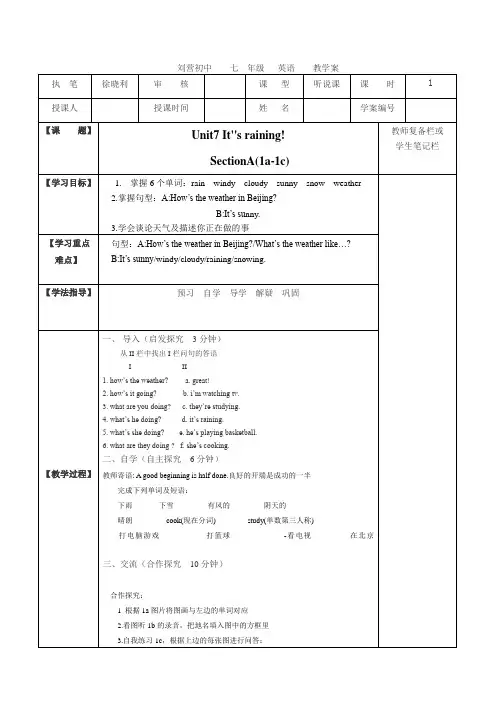
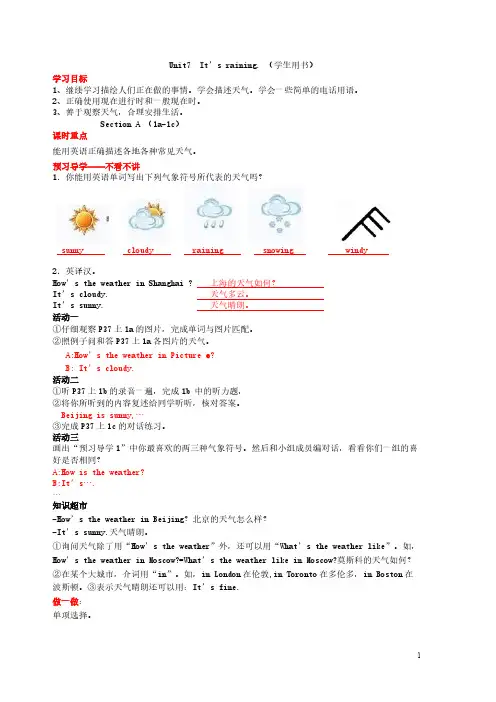
Unit7 It’s raining. (学生用书)学习目标1、继续学习描绘人们正在做的事情。
学会描述天气。
学会一些简单的电话用语。
2、正确使用现在进行时和一般现在时。
3、善于观察天气,合理安排生活。
Section A (1a-1c )课时重点能用英语正确描述各地各种常见天气。
预习导学——不看不讲1.你能用英语单词写出下列气象符号所代表的天气吗?sunny cloudy raining snowing windy 2.英译汉。
How’s the weather in Shanghai ? 上海的天气如何? It’s cloudy. 天气多云。
It’s sunny. 天气晴朗。
活动一 ①仔细观察P37上1a 的图片,完成单词与图片匹配。
②照例子问和答P37上1a 各图片的天气。
A:How’s the weather in Picture e ?B: It’s cloudy.活动二 ①听P37上1b 的录音一遍,完成1b 中的听力题,②将你所听到的内容复述给同学听听,核对答案。
Beijing is sunny,…③完成P37上1c 的对话练习。
活动三 画出“预习导学1”中你最喜欢的两三种气象符号。
然后和小组成员编对话,看看你们一组的喜好是否相同?A:How is the weather?B:It’s….…知识超市-How’s the weather in Beijing ?北京的天气怎么样?-It’s sunny.天气晴朗。
①询问天气除了用“How’s the weather”外,还可以用“What’s the weather like”。
如,How’s the weather in Moscow?=What’s the weather like in Moscow?莫斯科的天气如何?②在某个大城市,介词用“in”。
如,in London 在伦敦,in Toronto 在多伦多,in Boston 在波斯顿。
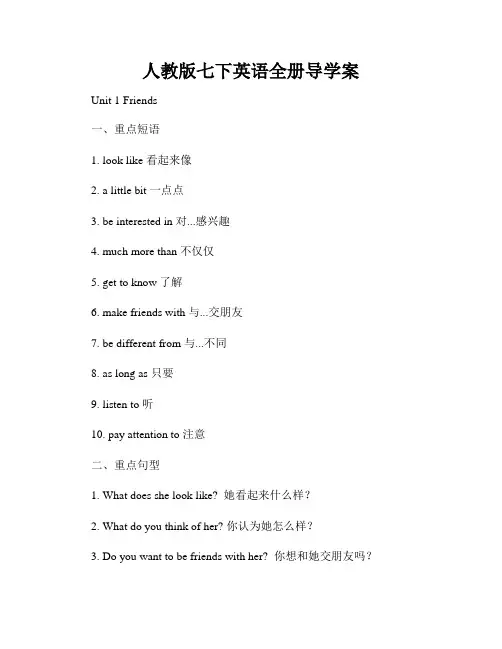
人教版七下英语全册导学案Unit 1 Friends一、重点短语1. look like 看起来像2. a little bit 一点点3. be interested in 对...感兴趣4. much more than 不仅仅5. get to know 了解6. make friends with 与...交朋友7. be different from 与...不同8. as long as 只要9. listen to 听10. pay attention to 注意二、重点句型1. What does she look like? 她看起来什么样?2. What do you think of her? 你认为她怎么样?3. Do you want to be friends with her? 你想和她交朋友吗?4. How do you get on with your classmates? 你和你的同学相处得怎么样?5. I think she is friendly and outgoing. 我认为她友好并且外向。
6. I’m not very outgoing, but I’m very kind. 我不太外向,但是我很善良。
7. As long as she is friendly, I’m happy to make friends with her. 只要她友好,我很高兴和她交朋友。
8. He is different from me, but he gets on well with his classmates. 他和我不同,但是他和他的同学相处得很好。
9. I pay attention to my friend s’ feelings because I think it’s important. 我关注我的朋友的感受,因为我认为这很重要。
三、词汇运用1. 根据句意和首字母提示填入适当的词1) My cousin looks like her father, but she is a l_________ like her mother.2) He is very friendly and o_________. He has many friends.3) My sister is very k________ to everyone and she gets on well with her classmates.4) She is not very o________, but she is very easygoing.5) Nick is different from his brother. He is more i________ in music.2. 选择合适的词填入空格1) My friend is very _________ (outgoing, interested) in basketball and he plays it every day.2) Lucy pays a lot of attention to her _________ (families, friends) because she cares about them.3) My grandfather is very _________ (kind, similar) to all his grandchildren and he loves us very much.4) She is a little bit _________ (friendly, different) from others, but she also has many friends.5) If you want to _________(get to know, make friends) with someone, you need to be friendly and kind.Unit 2 Festivals一、重点短语1. at the beginning of 在...开始时2. send sb. sth. 向某人送去…3. in the west 在西方4. unlike sb./sth. 不同于5. look like 看起来像6. wear costumes 穿着服装7. on the 15th day of the 1st lunar month 农历正月十五8. be similar to 与...相似9. make dumplings 包饺子10. have fun 玩得开心二、重点句型1. What do people do on Mid-Autumn Festival? 中秋节的时候人们做什么?2. Are there any differences among different countries? 不同国家有什么不同之处?3. What do you think of the festival? 你觉得这个节日怎么样?4. In China, people often eat moon cakes during Mid-Autumn Festival. 在中国,中秋节的时候人们常吃月饼。
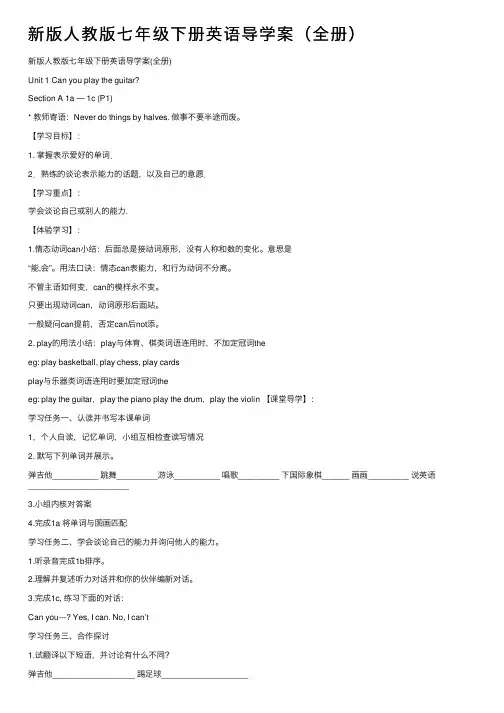
新版⼈教版七年级下册英语导学案(全册)新版⼈教版七年级下册英语导学案(全册)Unit 1 Can you play the guitar?Section A 1a — 1c (P1)* 教师寄语:Never do things by halves. 做事不要半途⽽废。
【学习⽬标】:1. 掌握表⽰爱好的单词.2.熟练的谈论表⽰能⼒的话题,以及⾃⼰的意愿.【学习重点】:学会谈论⾃⼰或别⼈的能⼒.【体验学习】:1.情态动词can⼩结:后⾯总是接动词原形,没有⼈称和数的变化。
意思是“能,会”。
⽤法⼝诀:情态can表能⼒,和⾏为动词不分离。
不管主语如何变,can的模样永不变。
只要出现动词can,动词原形后⾯站。
⼀般疑问can提前,否定can后not添。
2. play的⽤法⼩结:play与体育、棋类词语连⽤时,不加定冠词theeg: play basketball, play chess, play cardsplay与乐器类词语连⽤时要加定冠词theeg: play the guitar,play the piano play the drum,play the violin 【课堂导学】:学习任务⼀、认读并书写本课单词1,个⼈⾃读,记忆单词,⼩组互相检查读写情况2. 默写下列单词并展⽰。
弹吉他__________ 跳舞_________游泳__________ 唱歌_________ 下国际象棋______ 画画_________ 说英语______________________3.⼩组内核对答案4.完成1a 将单词与图画匹配学习任务⼆、学会谈论⾃⼰的能⼒并询问他⼈的能⼒。
1.听录⾳完成1b排序。
2.理解并复述听⼒对话并和你的伙伴编新对话。
3.完成1c, 练习下⾯的对话:Can you---? Yes, I can. No, I can’t学习任务三、合作探讨1.试翻译以下短语,并讨论有什么不同?弹吉他__________________ 踢⾜球___________________2.讨论如何询问第三⼈称能⼒的句型---Can he sing? ---Yes, he can. / No, he can't.---Can Tom speak English? ---Yes, he can. / No, he can't.【⾃主检测】:I.精挑细选1. Can you ________ English?A. speakB. talkC. say2. Can he __________ basketball?A. playB. playsC. playing3. My brother want _______ the chess club.A. joinB. to joinC. joins4. Mary can play the chess________ she can't swim.A. andB. orC. but5. His brother plays _______ piano every day.A. /B. aC. theII.翻译官说英语_____________ 弹吉他_____________ 象棋俱乐部__________ 下象棋______________ 英语俱乐部_____________ ⾳乐俱乐部__________ 美术俱乐部___________ 游泳俱乐部_____________ 参加___________ Ⅲ. 补全对话A. Can you ___________(唱歌)?B. Yes, I ________. Can you _________(游泳)?A. No, I want to join _______________(象棋俱乐部).B. I don't like ______________(象棋)A. What club do you want to __________?Unit 1 Can you play the guitar?Section A 2a— 2d (P2)* 教师寄语:Never do things by halves. 做事不要半途⽽废。
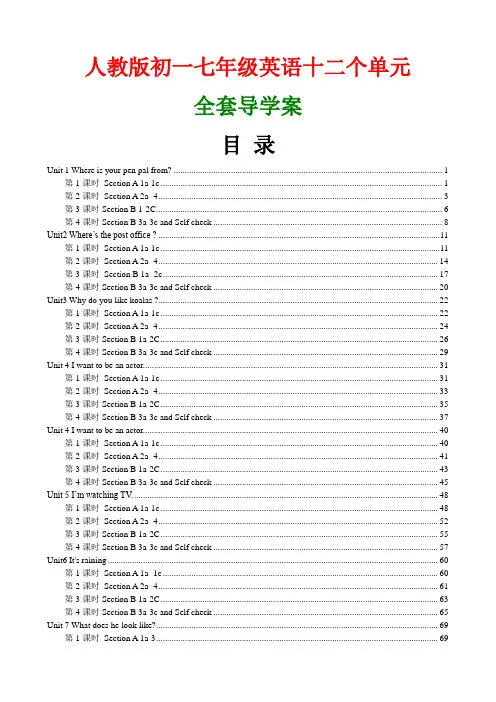
人教版初一七年级英语十二个单元全套导学案目录Unit 1 Where is your pen pal from? (1)第1课时Section A 1a-1c (1)第2课时Section A 2a -4 (3)第3课时Section B 1-2C (6)第4课时Section B 3a-3c and Self check (8)Unit2 Where’s the post office ? (11)第1课时Section A 1a-1c (11)第2课时Section A 2a -4 (14)第3课时Section B 1a -2c (17)第4课时Section B 3a-3c and Self check (20)Unit3 Why do you like koalas ? (22)第1课时Section A 1a-1c (22)第2课时Section A 2a -4 (24)第3课时Section B 1a-2C (26)第4课时Section B 3a-3c and Self check (29)Unit 4 I want to be an actor. (31)第1课时Section A 1a-1c (31)第2课时Section A 2a -4 (33)第3课时Section B 1a-2C (35)第4课时Section B 3a-3c and Self check (37)Unit 4 I want to be an actor. (40)第1课时Section A 1a-1c (40)第2课时Section A 2a -4 (41)第3课时Section B 1a-2C (43)第4课时Section B 3a-3c and Self check (45)Unit 5 I’m watching TV (48)第1课时Section A 1a-1c (48)第2课时Section A 2a -4 (52)第3课时Section B 1a-2C (55)第4课时Section B 3a-3c and Self check (57)Unit6 It's raining (60)第1课时Section A 1a -1c (60)第2课时Section A 2a -4 (61)第3课时Section B 1a-2C (63)第4课时Section B 3a-3c and Self check (65)Unit 7 What does he look like? (69)第1课时Section A 1a-3 (69)第2课时Section A 3a -4 (72)第3课时Section B 1a-2C (76)第4课时Section B 3a-3c and Self check (78)Unit 8 I’d like some noodles (83)第1课时Section A 1a-1c (83)第2课时Sectiona A 2a-4 (85)第3课时Section B 1a-2c (88)第4课时Section B 3a-4 and Self check (92)Unit9 How was your weekends? (97)第1课时Section A 1a-1c (97)第2课时Section A 2a -4 (99)第3课时Section B 1a-2C and Shelf check-3 (102)第4课时Section B 3a-3c (105)Unit 10 Where did you go on vacation? (109)第1课时Section A 1a-1c (109)第2课时Section A 3a -4 (112)第3课时Section B 1a-2C (113)第4课时Section B 3a-3c and Self check (116)Unit 11 What do you think of game shows? (119)第1课时Section A 1a-2c (119)第2课时Section A 3a -4 (123)第3课时Section B 1a-2C (125)第4课时Section B 3a-3c and Self check (128)Unit 12 Don't eat in class. (133)第1课时Section A 1a-1c (133)第2课时Section A 2a -4 (135)第3课时Section B 1a-2C (140)第4课时Section B 3a-3c and Self check (141)七年级英语下册第一单元学案Unit 1 Where is your pen pal from?第1课时Section A 1a-1c【学习目标】1. 掌握P 1 单词2.掌握句型:—Where is your pen pal from? —He is from Australia.3.掌握世界上一些国家的英文名称及地理位置。

初中英语新目标教材导学案七年级下册Unit7It’s raining!学校:农安县第三初级中学年班:一年八班任课教师:李海靖2014年2月---2014年7月导学案的要求和使用导学案倡导学生自主学习,自主探索,自我发现,自我解决,是学生学会学习,学会合作,学会发展的有效途径,从而转变教师的教学观念和教学方式,转变学生学习方式,优化课堂模式。
导学案的设计要包括教材分析及学情分析、学习目标(三维目标、重点、难点、考点)、预习导学、新知探究、课内巩固、课后反思等基本要素。
重点体现:学案自学→以案导学→合作探究→巩固练习。
具体要求:1、每单元已有两课时的内容进行县级主备,各校组织本校教师进行剩余课时内容的主备工作;2、课型要注明听说课、阅读课、写作课或讲评课等;3、在预习导学和课内巩固的习题等配备上一定要侧重分层教学的实施。
4、单元内容检测情况要在学案上有所体现。
5、至少一篇本单元典型案例及分析。
教师寄语:____________________________________________________________ ____________________________________________________________ ____________________________________________________________ ____________________________________________________________教学进度及单元主备分工表时间教学内容主备人备注附:1、每个单元(含每月一次检测)进行一次检测,时间自行安排。
2、检测题要在教(学)案中有所体现,检测后及时进行反馈。
3、大型教研活动,需对教学计划做以调整,可另外在备注中加以说明。
4、法定假日、期中和期末考试除外。
2013人教版新目标英语七年级(下)Unit7It’s raining!主备人:李海靖(三中)一、教材分析:本单元的中心话题是谈论天气,涉及两个主要语言功能项目:一是运用How’s the weather?及描述天气情况的形容词来谈论不同城市的天气情况;二是继续运用现在进行时态来描述人们的即时活动。
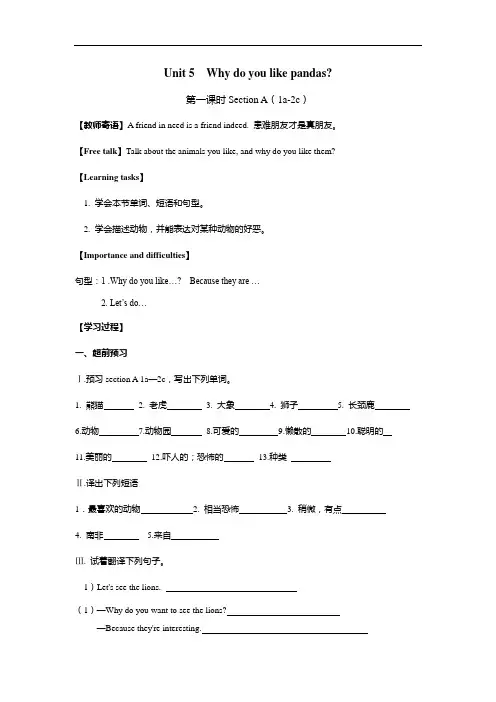
Unit 5 Why do you like pandas?第一课时Section A(1a-2c)【教师寄语】A friend in need is a friend indeed. 患难朋友才是真朋友。
【Free talk】Talk about the animals you like, and why do you like them?【Learning tasks】1. 学会本节单词、短语和句型。
2. 学会描述动物,并能表达对某种动物的好恶。
【Importance and difficulties】句型:1 .Why do you like…? Because they are …2. Let’s do…【学习过程】一、超前预习Ⅰ.预习section A 1a—2c,写出下列单词。
1. 熊猫2. 老虎3. 大象4. 狮子5. 长颈鹿6.动物7.动物园8.可爱的9.懒散的10.聪明的11.美丽的12.吓人的;恐怖的13.种类Ⅱ.译出下列短语1.最喜欢的动物 2. 相当恐怖 3. 稍微,有点4. 南非5.来自Ⅲ. 试着翻译下列句子。
1)Let's see the lions.(1)—Why do you want to see the lions?—Because they're interesting.IV. 找出你的疑惑:____________________________________________________________________________________________________________________________二、课中学习I. 预习检测写出本课中的七个描述品质特征的形容词:我们学过的此类形容词还有:II. 解决疑惑自主互助学习知识剖析:1.Let's see the lions. 让我们看狮子吧!Let's = Let us 意思是“让我们.......吧。

七年级下册英语导学案(全集)Unit 1 Where is your pen pal from?导学案1 Section A 1a--Grammar focus【学习⽬标】1.学会⼀些国家和城市的英⽂名称,:会⽤所学知识,询问和回答⼈们来⾃哪⾥。
2.学会理解和尊重异国⽂化.【学法指导】1、联系⽣活学习英语。
敢于⽤英语表达,⽤英语进⾏交际。
2、听⼒策略:A. 放松⼼情。
B. 注意关键字【课前准备】准备⼀张世界地图.【学习过程】⼀、预习指导与检测(⼀)预习指导1.预习第1-2页的⽣词,根据⾳标会读知意.2.朗读第1-2页的句型,能英汉互译.3.知识点拨:1)Where is/are + 主语 + from ?这⼀特殊疑问句⽤来询问某⼈来⾃哪⾥,回答时,⽤主语+is/are +from+地点。
eg:Where are you from? I’m from Chaohu. Where is he from? He’sfrom Hefei.拓展:be from = come from be是系动词,come 是实义动词eg: Where does he come from? He comes from Hefei.2)live 不及物动词,意思是“居住”不能直接加地点,需要有介词.eg: ----- Where does she live? ------She lives in Paris.3)pen pal =pen friend 笔友4)China 中国 Chinese 中国⼈ Japan ⽇本 Japanese ⽇本⼈eg:We are all Chinese. The three girl are Australians.(⼆)预习检测1.你知道这些国家和地区的英⽂名称吗?(1)中国_______(2) 加拿⼤ ________ (3)法国 ________(4)英国_________ (5)澳⼤利亚______(6) 美国_______(7)新加坡______ (8)悉尼________ (9) 巴黎_______(10)纽约________(11)多伦多_______(12)东京_________⼆、课堂互动探究1. ⼩组活动:1) 共同总结本节课的重点单词及短语,然后互相提问。
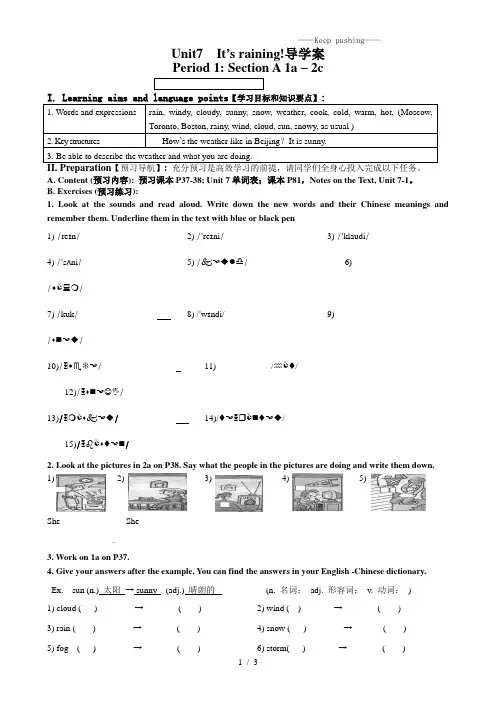
Unit7 It’s raining!导学案Period 1: Section A 1a – 2cI. Learning aims and language points【学习目标和知识要点】:1. Words and expressions rain, windy, cloudy, sunny, snow, weather, cook, cold, warm, hot, (Moscow,Toronto, Boston, rainy, wind, cloud, sun, snowy, as usual )2. Key structures How’s the weather like in Beijing?It is sunny.3.Be able to describe the weather and what you are doing.II. Preparation【预习导航】:充分预习是高效学习的前提,请同学们全身心投入完成以下任务。
A. Content (预习内容): 预习课本P37-38; Unit 7单词表;课本P81,Notes on the Text, Unit 7-1。
B. Exercises (预习练习):1. Look at the sounds and read aloud. Write down the new words and their Chinese meanings and remember them. Underline them in the text with blue or black pen1) /reɪn/_____________________ 2) /ˈreɪni/____________________ 3) /ˈklaudi/_________________ 4) /ˈsʌni/____________________ 5) / ☜◆●♎/____________________ 6)/♦❍/__________________7) /kuk/__________________ 8) /ˈwɪndi/_____________________ 9)/♦⏹☜◆/___________________10)/ ♦♏❆☜/_________________ 11) /♒♦/ ______________________12)/ ♦⏹☜☺✋/_________________13)/ ❍♦☜◆/_____________ 14)/♦☜❒⏹♦☜◆/__________________15)/ ♌♦♦☜⏹/________________2. Look at the pictures in 2a on P38. Say what the people in the pictures are doing and write them down. 1) 2) 3) 4) 5)She ___________ She __________ ______________ _______________ ________________ _____________. ______________ ______________ _______________ ________________3. Work on 1a on P37.4. Give your answers after the example. Y ou can find the answers in your English -Chinese dictionary. Ex. sun (n.) 太阳→ sunny (adj.) 晴朗的(n. 名词;adj. 形容词;v. 动词;)1) cloud ( )________ → _______ ( )_________ 2) wind ( )_______ → _______ ( )__________ 3) rain ( )________ → _______ ( )_________ 4) snow ( ) ________→ ______ ( )_________ 5) fog ( )________ → _______ ( )_________ 6) storm( )_______ → _______ ( )_________5. Look at the pictures and complete the sentences.1)○2How’s ________________ _________________________in Beijing? in Shanghai?It’s __________________. ________________________III. Procedures 【课堂学习】Step 1. Preparation for 2a and 2b1. Work in groups and discuss the answers to Ex. 1 &2.2. Display the answers to Ex. 1 & 2.Step 2. Listening and speaking practice1. Work on 2a. Listen and number the pictures.2. Work on 2b. Listen and match the names with activities.3. Work on 2c. Ask and answer the questions.4. Read after the tape and imitate the conversation in 2a & 2b.Step 3. Preparation for 1a, 1b & 1c.1. Work in groups and discuss the answers to Ex. 3, 4 & 5.2. Display the answers to Ex. 3, 4 & 5.Step 4. Listening and speaking practice.1. Work on 1b. Write the city names in the boxes in the picture in 1a and check the answers.2. Listen again and write the weather vocabulary(天气词汇) under the city names.3. Report the answers like, “It’s sunny in Beijing”.4. Listen and repeat. Imitate the pronunciation.5. Ss work in pairs and practice the conversation in 1c. Check some pairs.Step 5. Making conversations.1. Look at the pictures in 3b and fill in the chart.2. Imagine you are the people in the pictures and make a telephone conversation.A: Hello, _____________ speaking.B: Hi, ___________. This is _____________ speaking. A: What are you doing, _____________?B: _________________________________________. What about you? What are you doing?A: _________________________________________. ___________ the weather there? Is it ___________? B: No, it isn’t. ________________________________. __________________________ in your place?A: Well, ________________________________. Ok, have a nice day!B: Thanks! You, too.A: Thank you! Goodbye.B: Goodbye!3. Display your conversations before the class. Catch your chance(抓住机会).(There are three chances.) (A段展示分满分为2分,B段为4分,C段为6分)IV. Test 【课堂检测】:根据课文内容填空。

人教版新目标七年级下册英语导学案Unit7 It’s raining.第1课时 Section A(P37.38 页1a—2c)班级: 姓名:教师寄语:Save for a rainy day. 未雨绸缪。
【学习目标】1、知识与技能:掌握单词2、过程与方法: 1)、听说训练2)、能利用所学知识进行话。
.3、情感态度、价值观:积极参与小组活动,大胆展示。
【学习重点】1.学会使用学问天气状况的用法,及答语句型—How is the weather.It’s cloudy2.学会【学习过程】一、课前预习1.自己拼读、听磁带朗读单词,背单词。
2.听本节录音材料,并跟读。
3.单词检测下雨;雨水多雨的_________ 风多风的云____________ 多云的晴朗的_________ 下雪;雪天气做饭4.短语玩篮球看电视像往常5. 重点句型1. 上海的天气怎么样?多云2.北京的天气怎么样?天气晴朗3. 莫斯科的天气怎么样现在正在下雪4.多伦多的天气怎么样?像往常一样,正在下雨5. 乔叔叔在那吗?不,不在。
他在外面。
6.乔叔叔在做什么?7. 萨利婶婶在哪吗?是的,她在,但是她现在正在忙。
8.你想和她谈话,不是吗?二、课堂学习Step1 Free talkTry to speak out the names of weather you know.Step2 Presentation1.Learn the new words about weather in 1a.2.Finish 1a. Then check the answers.3.Look at the picture in 1a and learn the drills:--How’s the weather in …? -- It’s ….Step3 ListeningListen and finish 1b. Check the answers.Step4 Pair workPractice the conversations in 1a .Then make your own conversations. Step5 Presentation1.Look at the picture in 2a.2.Guess what the people are doing.Step6 Listening1. Listen to the tape. Finish2a.2. Go through the sentences in 2b.3. Listen and finish 2b. Check the answers.Step7 Pair work1. Ask and answer questions with your partner. Finish 2c.三、过关检测:(一)根据句意,补全已给出首字母的单词1. ---The w in Beijing is hot now.2.---It smells so good.---My sister is c fish in the kitchen.3.---What do you do on r days.---I read some books at home.4.---The sky is so blue.---Yes, it is a s day.(二)用所给词的适当形式填空1. ---Look! They (study) in the classroom.2. ---My brother often (watch) football matches on TV.3. ---We can’t go out now. It’s (rain) so hard.4. ---It’s (cloud), but it’s very hot.【拓展延伸】1. 询问天气状况的用法:问:How’s the weather in + 地点= What’s the weather like in + 地点答:It’s + 表示天气状况的形容词Eg: the weather in Shanghai?= the weather like in Shanghai.?It’s cloudy/ windy/ sunny/ foggy2. Weather 的含义weather 意为“天气”,为不可数名词,不能与a 或an 连用。

峨山县初中英语学科“问题导学、互动探究”学案峨山县初中英语学科“问题导学、互动探究”学案峨山县初中英语学科“问题导学、互动探究”学案峨山县初中英语学科“问题导学、互动探究”学案峨山县初中英语学科“问题导学、互动探究”学案【快乐阅读】:WeatherWe often talk about the weather. If we want to know about the weather,We can turn on the radio and listen to the weather report. We can also turn on the TVand watch Weather Forecast. And we can ask other people in two different ways:”What’s the weather like today?” or “How’s the weather today?” Sometimes we can call at 121 for the weather.When it’s cold, we shiver and need to wear warm clothes and scarves. When it’s hot, we need a cool place and want a cold drink.( ) 1. You can watch Weather Forecast _____.A. by radioB. on TVC. at 121( ) 2. You can ask other people”___________” to know about the weather.A. What does the weather like?B. What’s the weather?C. How’s the weather?( ) 3. The telephone number 121 is for _____.A. the addressB. the fireC. the weather( ) 4. The underlined word “shiver” means “_____” in Chinese.A. 颤抖B. 出汗C. 避暑( ) 5. We want a cold drink when it’s _____.A. coldB. warmC. hot【快乐链接】天气状况(2)Fog 雾Fair 晴Haze 薄雾Dust 灰尘Drifting Snow 飘雪Hail 冰雹Drizzle 毛毛雨Few Showers 短暂阵雨Few Snow Showers 短暂阵雪Few Snow Showers / Wind 短暂阵雪时有风峨山县初中英语学科“问题导学、互动探究”学案。
Unit7. It’s raining!1a—2c (Period 1)教师寄语:All things are difficult before they are easy. 凡事都是先难后易。
【学习目标】1. 学会使用How’s the weather?这询问天气状况的句型。
2. 会用英语描述天气,谈论在不同天气里所做的事情。
3. 学会通过询问天气展开话题,提升与人交流的水平。
4.重点单词:rain-raining-rainy wind-windy cloud-cloudy sun-sunny snow-snowing-snowy weather cook-cooking5.重点短语:Play computer games play basketball watch TV in Moscow /Toronto/ Boston6.重点句型:How is the weather +(in)+地点?=What is the weather like +(in)+地点?答:It’s +现在分词=It’s +adj。
【课前探究】(先蓝色笔做,用红笔订正。
)一、课前预习,根据音标写出英文和中文。
[reɪn]_________( ) ['reɪnɪ] _______( ) [wɪnd]__________( ) ['wɪndɪ]_________( )[klaʊd]________( ) ['klaʊdɪ] _______( ) ['sʌnɪ] __________( ) ['snəʊɪ] __________( )总结:名词+______, 构成adj.。
如:名词wind+y--windy;rain—rainy; cloud—cloudy; 特殊:sun—Sunny;二、理解记忆--重点句子。
1. How’s the weather in Shanghai/Beijing/Moscow/Toronto/Boston?2. It’s raining/cloudy/snowing/sunny.=What’s the weather like in…..today? 回答或者用“It’s sunny/windy/snowy/rainy cold/hot/warm/cool/ dry…”3.中考考感叹句:What bad weather! 注:weather “天气”, 是不可数名词。
【素材积累】
1、人生只有创造才能前进;只有适应才能生存。
博学之,审问之,慎思之,明辨之,笃行之。
我不知道将来会去何处但我知道我已经摘路上。
思想如钻子,必须集中摘一点钻下去才有力量。
失败也是我需要的,它和成功对我一样有价值。
2、为了做有效的生命潜能管理,从消极变为积极,你必须了解人生的最终目的。
你到底想要什么?一生中哪些对你而言是最重要的?什么是你一生当中最想完成的事?或许,你从来没有认真思量过生命潜能管理旧是以有系统的方法管理自我及周边资源,达成。